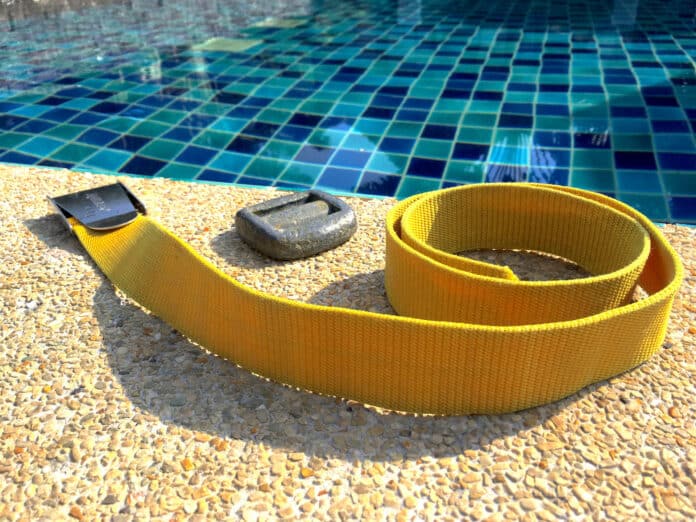SCUBA diving will require some weights. Some people will need more weights, and some people can go down with little to no weights. The weights help us go down and maintain our buoyancy; even when our tank becomes more buoyant and we need to make a controlled safety stop. So how to make a weight belt for diving, and what are the different types of weights that you might come across during your diving adventures?
How to make a weight belt for diving?
To make a weight belt for diving, always lay the belt and the weights on the floor. This will prevent any accidental dropping of weights. As we say to our students; if the weights drop on your foot, it’ll be painful, but if your weights drop on MY foot, you’ll be in even more pain!
Lay the belt on the ground with the buckle face up. Lay the weights with the rounded side on top, and the flat side on the ground. Putting the weights on the correct side will make it more comfortable when you are wearing the weights as it will lay flat against your wetsuit or rash guard.

Thread one end of the belt up and through the first slit, and then down through the second slit. Slide the weights to the buckle and then keep adding your required weights.


Ideally, you want the weights to sit on either side of your body, and be balanced. For example, if you need 4 weights, then slide two of the weights closer to the buckle, then leave a gap and slide the other two weights closer to the open end of the belt. I like to leave a gap as this is where the tank will sit on your back; it stops the tank from pushing the blocks uncomfortably into you!

Do I need my own weights and weight belt?
In the parts of the world where diving is commercialized and rental equipment is common, many divers will not own their own weights. Even if they own the full set of BCD, regulator, mask, wetsuit, fins, etc. they will usually rent weights (and a weight belt if required) alongside a tank.
Some people, however, do prefer to purchase and travel with their own weight belt. This is ideal if you need a specific length or prefer to have a personalized belt.
Whichever style you use, the effect is the same – wearing them helps make you sink.
What weight systems are available?
As with any scuba products, manufacturers have raced and competed with each other to develop the latest and coolest weight systems.
Weight Belt
The most common weight system is the weight belt and nearly all weights are designed to fit onto weight belts in one way or another.
Weight belts are very simple. Made of strong nylon webbing, a weight belt usually consists of the belt itself and a metal or plastic buckle. The buckles are designed to be quick release so that you can dump the belt and its weights in an emergency. Weights are then designed to fasten onto the belt.
Integrated Weight
The other type of weight system is ‘integrated weights.’ This is when the weights can be integrated into your BCD with a quick release for dumping the weights quickly and safely. Using an integrated weight system is very popular among dive professionals as it is less cumbersome. It also allows the dive pro to easily take weights out underwater if they find their customer needs an extra weight instead of taking off a whole weight belt.
What types of weight are there?
There are a number of styles of weight available:
Lead blocks – these are the most traditional weights you will still see most diver using. Typically weighing between 1 to 13 pounds (0.5 to 6 kilograms), these blocks are designed with two slits that allow them to be threaded easily onto a weight belt. While sometimes causing discomfort to divers on the land as they can dig into your hip bone or push against the BCD, you will hardly notice them once underwater. Available in uncoated bare metal or with a plastic or rubber coating, these long-time favorites are here to stay.
Bullet weights – these are similar to lead blocks but usually a bit smaller. Cylindrical in shape with a single slit through the middle, they are often more comfortable than block weights as they are lower-volume. Without the second slit however they are prone to sliding up and down the weight belt, so weight retainers are essential to keep them in place.
Lead shot bags or ‘soft weights’ – bags full of lead shot are becoming a popular alternative to solid weights. These are ideally suited to being used in BCD integrated weight systems or placing inside pockets so that they do not damage your equipment. Lead shot bags are ideal when practicing scuba diving in a swimming pool as if they were dropped during an exercise, they will not damage or crack the pool’s tiles.
Some lead shot bags come with an opening to thread directly onto a weight belt, while others are designed to be placed inside a weight belt with pockets. Be careful when buying soft weights to make sure the bag is completely sealed. This will prevent lead from seeping out into the ocean.
Conclusion
Learning how to make a weight belt for diving will become second nature after a few dives. The key is to make sure that you create the weight belt on the ground to stop you from dropping any weights onto the foot or onto your foot. And knowing how to make your weight belt quickly is very handy when someone yells out ‘whale shark’ and you need to enter the water ASAP!
